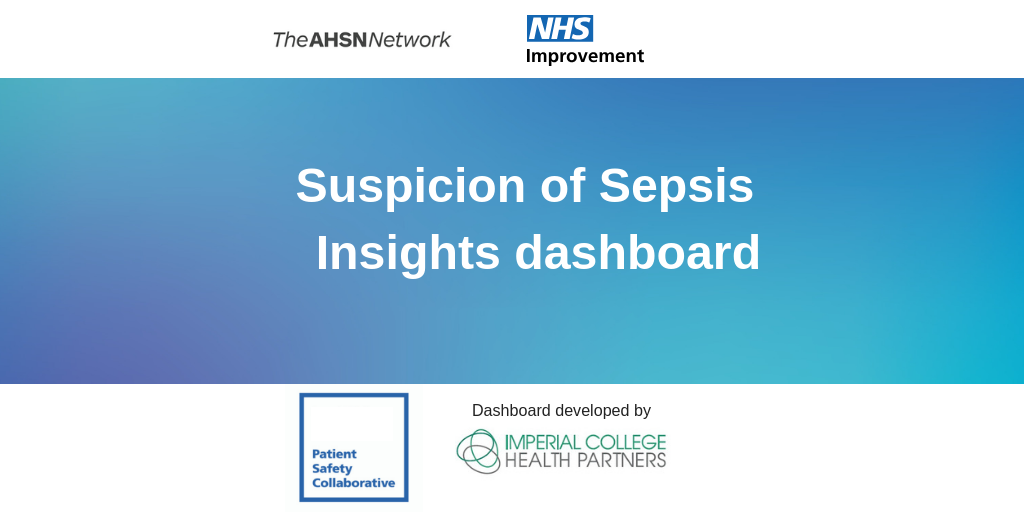
The SOS Dashboard enables NHS staff to improve patient care and reduces potential harm by – for the first time ever – providing fast, consistent, accurate and reliable data on sepsis outcomes. It saves healthcare professional’s time by making the data freely and easily accessible in usable format and provides relevant data which can be intelligently applied with precision to improve the quality of patient care. Local teams determine which methods work best over time, and which may need to be spread more widely across a region or nationally. It will ultimately help to better plan and prepare local services potentially saving lives across the country.
Sepsis is the severe, life-threatening end of infection, and arises when the body’s response to infection injures its own tissues and organs. Without early identification and treatment there is a significant risk of long-term disability or death. Sepsis doesn’t have a gold standard diagnostic test and the definition of the condition has varied over time, meaning that prior to the dashboard, its frequency and deaths could not be measured or compared over time, but only roughly estimated. This has been compounded by coding changes in recent years that led to an increase in reported sepsis numbers. This has highlighted the need for a proxy measure, and the only credible, reproducible and easily obtainable proxy measure is those admitted to hospital with infection- the Suspicion of Sepsis (SOS) category.
The Suspicion of Sepsis (SOS) Insights Dashboard tool enables NHS staff to improve patient care and reduce potential harm by providing consistent, fast, accurate, and reliable data on bacterial infection and sepsis at local, regional and national levels. It saves healthcare professionals’ time which can be refocussed back on bedside care. By making data freely and easily accessible in usable format, the tool provides relevant data which can be intelligently applied with precision to improve the quality of patient care.
The SOS Insight Dashboard is an example of what can be achieved through cross-system collaboration. The Dashboard has been created by Imperial College Health Partners (ICHP), through the Patient Safety Collaborative (PSC), with NHS Improvement’s Patient Safety Measurement Unit (PSMU) and NHS England all providing the unique breadth to bring partners together and spark cross-boundary critical conversations. Dr Matt Inada-Kim, National Clinical Advisor, and colleagues in Oxford, conceived the SOS category in 2017.
ICHP led on the concept, development and building of the Dashboard trialing it with clinicians as well as international figures in sepsis Mervyn Singer (Professor of Intensive Care Medicine at University College London) and John Welch (President, International Society for Rapid Response Systems).
The Dashboard for the first time enables organisations to see an overall picture of hospital admissions coded in the SOS category, allowing them to assess the scale at a local, regional, and national level. The tool has been used to demonstrate the regional effectiveness of the National Early Warning Score (NEWS 2) to save lives and to better understand regional winter variations in admission patterns.
The Dashboard provides intelligence as to whether interventions and innovations in sepsis / infection care are improving outcomes for patients. It will also help to better plan and prepare local services potentially saving lives across the country.
The Dashboard was launched in September 2018 by Care Minister Caroline Dinenage, alongside Celia Ingham Clark, NHS England’s Medical Director for Clinical Effectiveness at Imperial College Healthcare NHS Trust.
In the first year, the dashboard recorded nearly 670 views per month by 5140 users from 161 Trusts, 41 CCGs and 12 AHSNs. Additionally, the dashboard has drawn international interest from as far afield as New Zealand and won the prestigious Health Service Journal Patient Safety Award for the Best Emerging Patient Safety Solution. It has been included in the NHS Long Term Plan on Sepsis and the Royal College of Physicians (RCP) resource to support use of NEWS 2.
Kenny Ajayi, our Assistant Director, Quality Improvement & Safety, said ‘‘I’m immensely proud of the journey we have been on to develop this tool that enables NHS staff to improve patient care and reduces potential harm by – for the first time ever – providing consistent, accurate and reliable data on sepsis outcomes.”
“Sepsis is a devastating condition that is notoriously tricky to diagnose, so I’m delighted to support this important new tool. Not only will it let clinicians understand the impact of different interventions for sepsis, but crucially, in the future it could help analyse which infections lead to sepsis more often. It is yet another example of how technology is improving patient care in the NHS.”